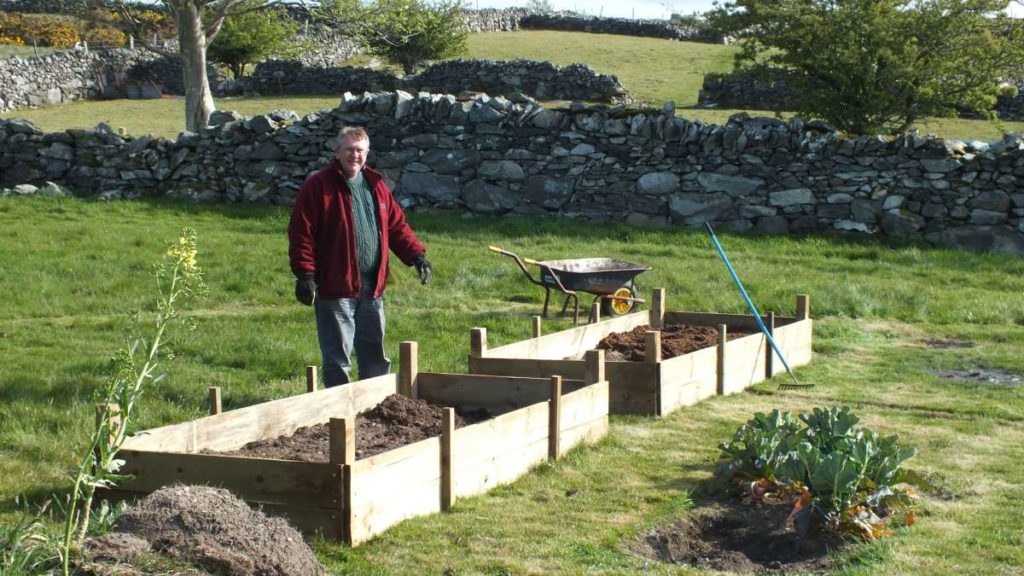The third page of gardening questions and answers this month! First a question on what wood to use for raised beds, then a heartfelt plea for help with white rot on the plot. Finally an unusual composting question.. can you compost a synthetic duvet?
What Wood to use to Construct Raised Beds
Julie asked:
I am new to gardening and want to get some raised frames to grow veg. What wood do you suggest? I don’t want toxic treated stuff do I ?
Many thanks
Julie
There are a few articles on raised beds which you may find helpful on the site including: How to Construct Raised Beds – Raised Deep Bed Growing
As to what wood to use, well if you start specifying hardwoods or cedar then you’re going to be paying a fortune. Just go to a builders merchant or sawmill and buy the required sizes (see the article) or see if you can pick up second-hand scaffolding boards.
You mention toxic treated – by which you mean tanalised, I assume. Tricky – wood will rot and untreated wood may only last three or four years. All preservative treatments are ‘toxic’ in the sense they stop bugs and fungi from destroying the wood. The question is whether the treatment affects the soil and crops.
Frankly, I don’t know. My feeling is that there must be some leaching of the treatment into the soil but I don’t think there is enough to be a real problem. I’ve yet to find a properly researched paper on the subject. Hysterical extrapolations of threat make good click-bait on the web but rarely have a real basis in fact.
If, after reading the article on raised beds, you still feel raised beds are your best solution but you’re concerned about using treated timber, consider using Link-a-Bord to construct the beds. Great product made from recycled plastic which is better than wood in that it doesn’t rot and being double-skinned will insulate the bed to a degree. But it ain’t cheap!
White Rot on the Plot
Ann contacted me
On Saturday I discovered white rot in my garlic so have pulled up the whole crop. It is next to onion sets, which although they look healthy now, will probably go down with it as well.
Various suggestions for unproven treatment are watering ground with onion or garlic water to fool the pathogen to come alive and die from lack of food – have you any idea how to make onion water, e.g. soaking onions or garlic in water? Another option was unproven use of Jeyes Fluid (think that came from your site that it is against EU/UK pesticide legislation.) Depending on where I read about this, the time lag for next planting ranges from 8 – 15 – 20 – 40 years! I practice a 4 year crop rotation so am most upset about it. Do you have any other ideas? As for burning the soil, not possible this time of year as our allotment site is banned from having bonfires between April – October!
As you’ve read in Onion Pests, Diseases & Problems, white rot is a devil of a disease. I’m afraid the only real answer is not to grow the onion family in that soil. As I said in the article:
Since you cannot grow on infected soil for eight years you need to consider alternatives such as using a completely separate plot of land or constructing a deep raised bed and filling with clean topsoil / compost.
Sorry I don’t have any better solutions than those I’ve already written in the article.
Can You Compost a Synthetic Duvet?
Lois asked:
Would the synthetic inners of a duvet decompose in a compost or have any use in a garden?
The synthetic inners of duvets are made from polyester microfibre which is a plastic, polyethylene terephthalate (PET). It may break down into small pieces but it won’t decompose into anything useful in the compost. It’s going to become polluting micro-plastics.
To be clear – do not try and compost polyester duvets.
I’m afraid I can’t see much use for it in the garden. I did wonder if it could serve as an insulator for a compost heap. Because it will get wet outside and hold water it won’t be much use for that. Polyester can be recycled in theory so I’d take it to the council waste recycling centre.
Feather duvets, however, can be useful in the garden – feathers will slowly rot down in the soil releasing nitrogen to the plants. They are more expensive – but you don’t buy a duvet every day.





Wood for raised beds.
Our kitchen garden has a substantial area of shallow, wet peat growing purple moor grass with heather over bedrock so raised beds were essential. We used treated (assume tanalised of some sort) timber from the local Agric suppliers plus old fence posts and so on. We then lined the sides with plastic sheet (left-over damp proof membrane) before filling. Strawberries have been in 4 years (yes, I plan to replace soon but they’re still going strong) with good harvests each year. New raised beds this year have produced huge crops of runner beans and massive tops on Jerusalem artichokes – crop to come. The best have been carrots, parsnips, onions and squash. The beds were filled with a mix of our own compost, sandy grit from the local quarry and rotted horse manure, about 50:30:20. We’re planning a seaweed mulch this winter as a trial. Home-made ‘net curtains’ around the carrot bed gave family a lot of amusement but kept the carrot root fly off!